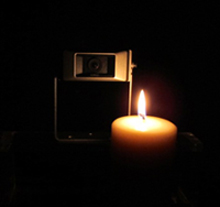Minimum Illumination or Low Light Sensitivity

You’ve read the specs. You’ve seen ratings down to zero lux. What do these ratings really mean? What is a lux, and how many do you need?
Camera systems generally work on the principal of “reflected light” meaning scene illumination is defined by the light being reflected from the scene. This needed reflected light is provided for the camera by the back-up lamps required on all vehicles.
According to FMVSS (108) and SAE (J593c), all vehicles are required to have working backup light or lights to aid the operator of the vehicle to see and for pedestrians and other drivers to see that the vehicle is backing. So the notion that the camera will need IR LEDs to illuminate the scene for the back-up camera in low-light conditions (at night for instance…) on a vehicle is an incorrect one. It suggests the camera and associated electronics so equipped is inadequate and needs more illumination than what is typically provided by the back up lamps to ‘work’ in lowlight conditions.
Vehicles have back-up lights. They’re required. And they’re required to be working. These lights provide more than enough illumination of the area to be monitored for the operator to see what’s back there with the INTEC camera.
Ever wonder why the cameras they equip automobiles with don’t have LED’s?
OK - now the less obvious. Let’s start with “What is a lux”?
Camera sensitivity is specified in lux. The lux (symbol: lx) is the SI unit of luminance (light). One lux is equal to one lumen per square meter meaning if you held a 1 square meter piece of paper one meter (39.37 inches) away from a standard candle, assuming you are in a dark room free from any other light, that paper would be illuminated to a brightness of one lux. The lower the lux rating the more the camera should be able to see in low light conditions.
So, what does it take to make a camera that works in very low light conditions? There are several ways to do it. Generally speaking, a camera with superior optics will give you a truer reproduction than one that relies on electronics. The goal of superior optics is to deliver as much light as possible to the imaging sensor (CCD).
Optically superior cameras start with a quality lens. Not only will a high-end lens allow more total light to reach the CCD, higher quality lenses yield sharper detail, controlled distortion, and colors that are more vibrant. Using high-quality imaging components ensures a high-quality image. This approach costs more and the end result is an imager that provides a useable image across the entire screen in both light and dark applications.
The lower cost alternative method prominent in the marketplace today is to surround the area around the camera’s lens with LEDs. While these ‘illuminators’ offer the ability to see in virtual darkness, that ability is hampered in most vehicle applications by the short distance and narrow width at which they operate and the “tunnel effect” they create. The net result is only a portion of the scene or field of view is useable, and all detail outside of that area virtually unusable because of the negative effects of the electronic enhancements have as a result of the concentration of light in only one area of the camera view. Additionally, there are hazards involved when working around IR Illumination. See the section on Infrared LED's for more information.
INTEC specifies the sensitivity of the camera, i.e. the minimum illumination for useable video – an image the operator can ascertain while operating the vehicle – across the entire field of view and not just a portion of the image that may be illuminated by LED’s.
Which camera system provides better value to the customer?
INTEC uses only superior optics and sensors that deliver the clearest image in both light and dark environments, across the entire field of view. All cameras require a minimum light level to provide a useable video signal. We design our cameras to perform normally with a pair of working back up lamps. We do this to ensure a useable image across the entire field of view in a typical vehicle based application. LEDs illuminate only a small portion of the view - if it was a comparable field of view, and actually function as a detriment to the entire field of view. That’s one reason why camera manufacturers that use LEDs use such narrow field of view lens – so as to create the appearance that they're illuminating the entire area. Don’t be fooled by attempts to compensate for cheap components and poor performance. Cameras that use LEDs to provide a useable video image suggest the camera and its associated electronics are either inadequate to function in ‘typical’ vehicle application or that the camera itself was designed for some other purpose, i.e. building security or baby nursery monitoring.
Overall a better lens and image sensor not only gives you a more useable image in low light conditions across the entire field of view, it provides an image with better resolution and clarity in all applications and under all lighting conditions.
The chart below can shed some light on lux levels under different ambient lighting conditions.

Don’t be fooled with gimmicks that attempt to compensate for cheap components and poor performance. INTEC uses only superior optics and sensors that deliver the clearest image in both light and dark environments, across the entire field of view.